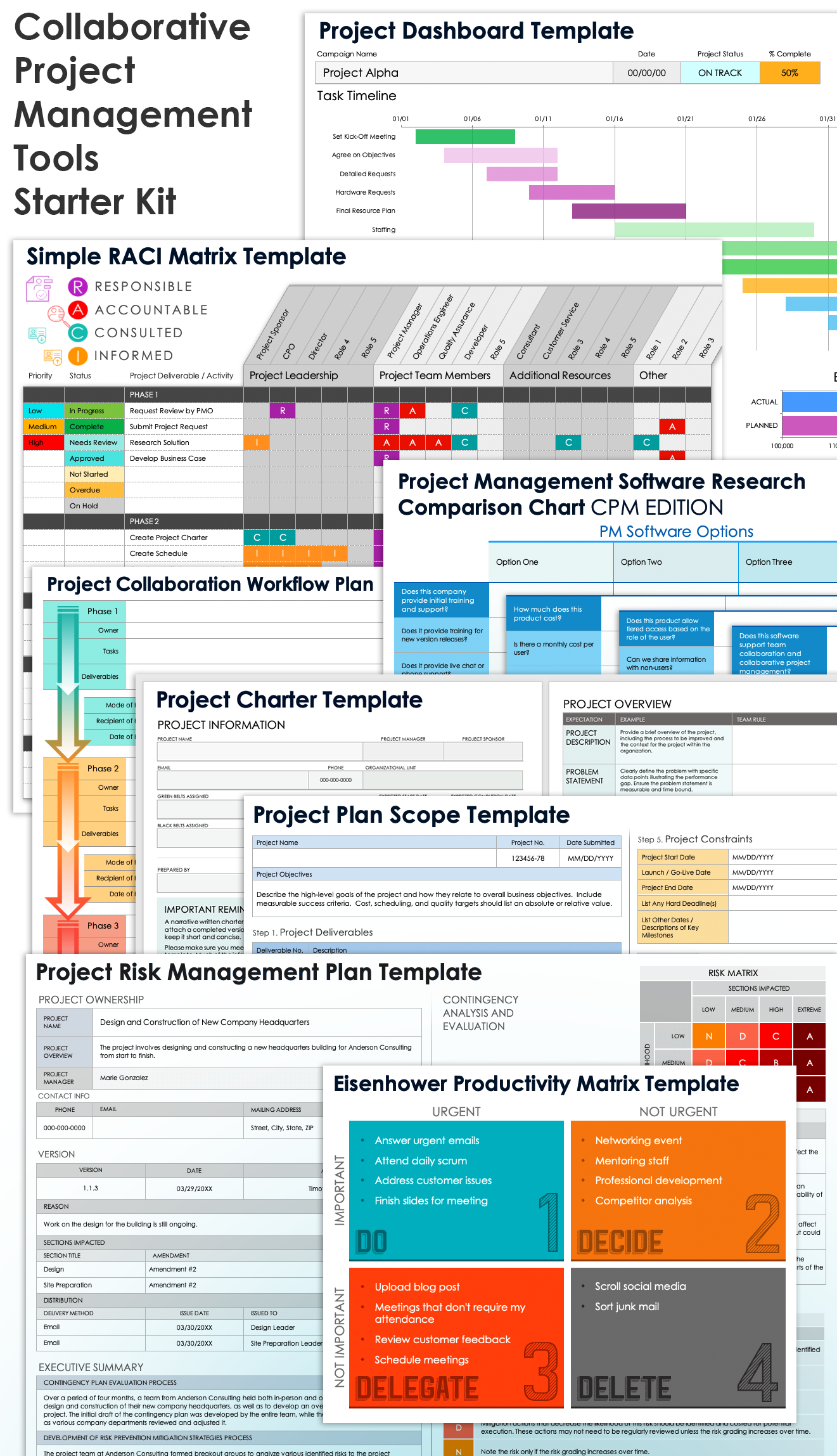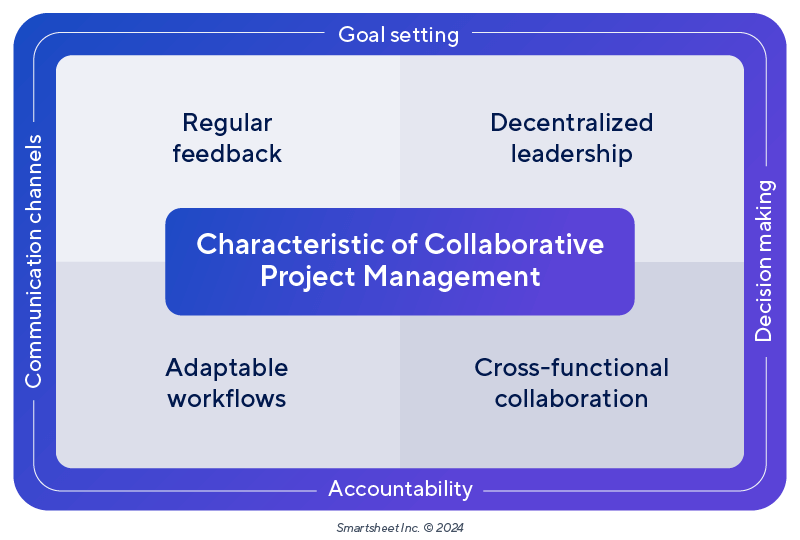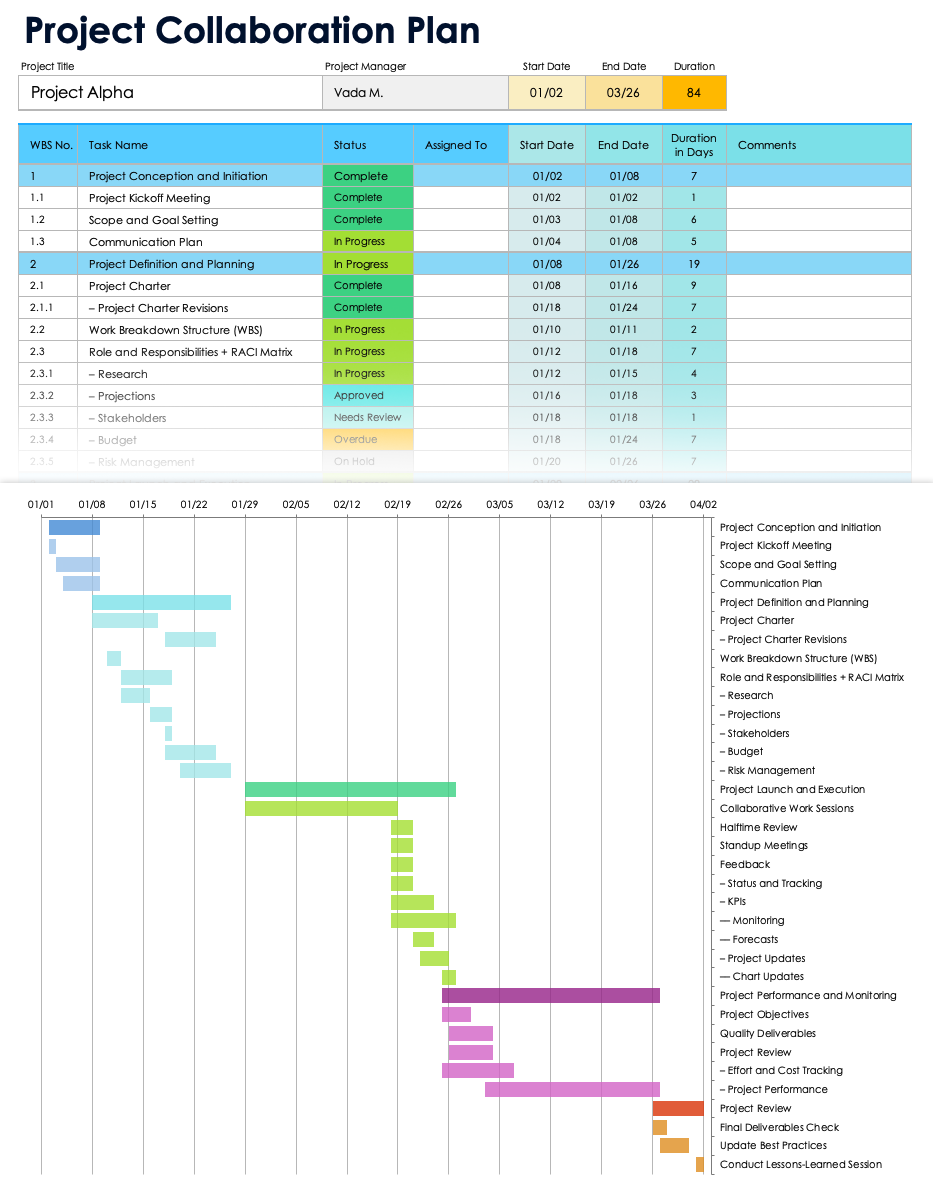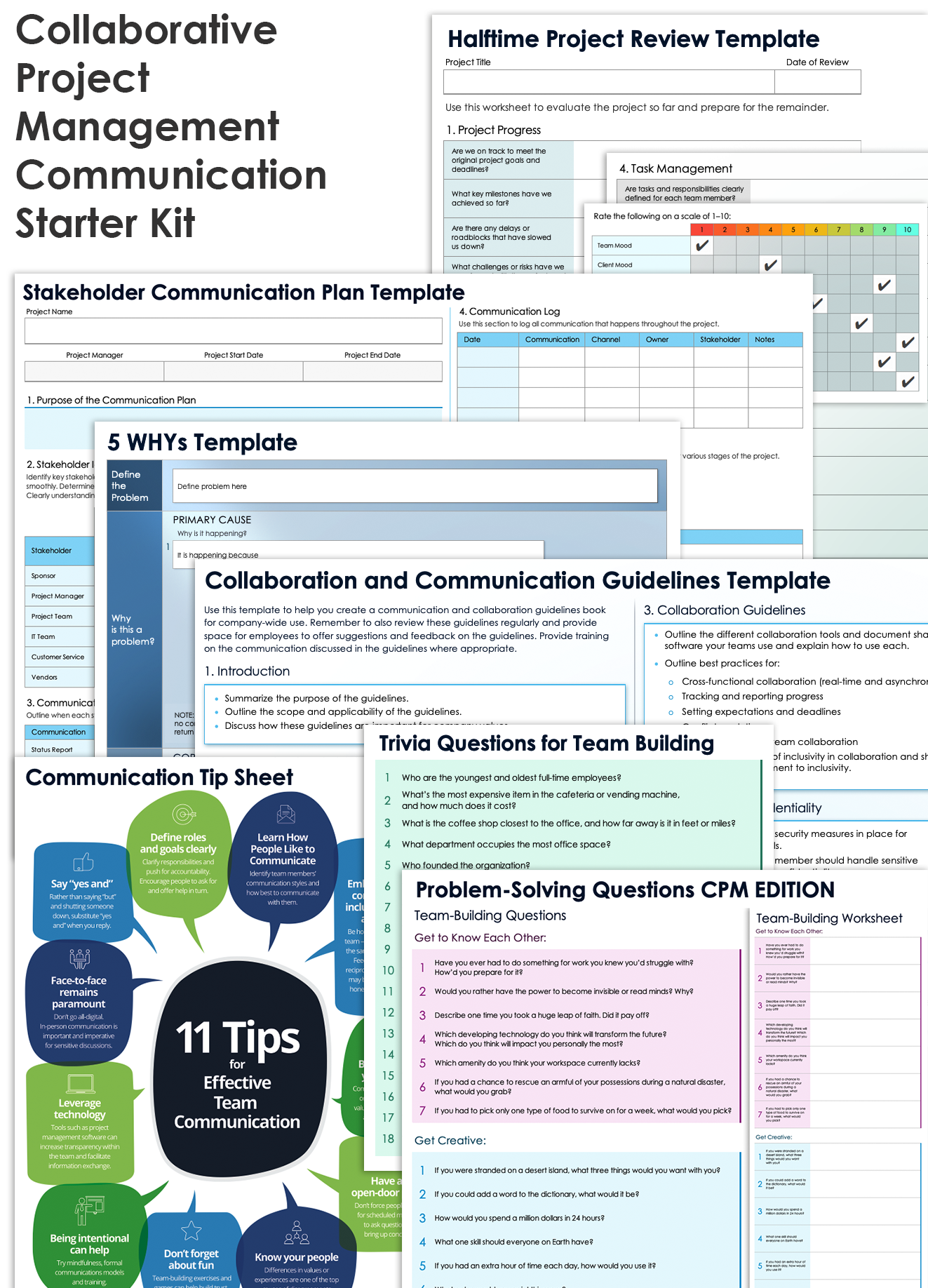What Is Project Collaboration?
Project collaboration is when multiple individuals or teams share ideas, knowledge, and resources in order to accomplish a common project goal. Project collaboration involves stakeholder coordination over the course of the entire project to execute on project tasks.
Effective collaboration requires large teams to work together throughout the project while keeping in mind each other’s needs and timelines, as well as remaining accountable to each other and to the shared goal. You will often collaborate with teams across a range of departments. A collaborative team must often use tools, software, or shared platforms in order to communicate effectively; to build trust; and to collectively plan, implement, and monitor a project from start to finish.
Here are some examples of projects that require project collaboration:
- Campaign Launch: Launching a marketing campaign involves collaboration between marketing strategists, content creators, social media managers, designers, copywriters, marketing analysts, and other experts. Together, they conduct market research, brainstorm the larger campaign concept, create print and digital marketing material, execute social media campaigns, monitor customer responses, collect and analyze data, and more. A project manager oversees the cross-team coordination and allocates resources as needed to keep the campaign within scope, deadline, and budget.
- Client Conference: To organize a client conference, several departments need to work together: The product team prepares demos or workshops, the sales team engages key customers and attendees, the marketing team promotes the event, community managers and event managers organize logistics and customer support, and more. The project manager might be responsible for guiding the program agenda, coordinating with venues and vendors, managing budget, coordinating teams, developing contingency plans, and overseeing on-site management.
- Mobile App: Releasing a new app or an app update requires multiple teams to collaborate: developers to build the product, designers to create the interface, quality assurance professionals to run tests and collect data, analysts to coordinate with the business team, security experts to ensure compliance, and a marketing team to sell the app to customers. The project manager or product owner oversees the project to ensure it stays on track, aligns with business standards and stakeholders’ expectations, and remains within budget.
Project Management vs. Project Collaboration
Project management is the process of taking a project from start to finish by establishing workflows, allocating resources, and implementing a vision. Project collaboration refers to the way teams work together to maintain this vision through open communication.
Project management and project collaboration share some of the same elements, such as setting goals, establishing clear objectives, assigning responsibilities, sharing updates, tracking progress, and incorporating feedback.
However, project management often involves a centralized project manager who coordinates with individuals. Project collaboration refers to a more decentralized practice, where teams are responsible for various tasks and talk to each other in a less formal manner. Project collaboration has a lower risk of bottlenecks, since teams remain accountable to each other but can work with more independence and flexibility.
Below are some key elements that are common to project management and project collaboration, but are slightly different in implementation:
| Common Project Phase | Project Management | Project Collaboration |
|---|---|---|
| Common Project Phase Create a project plan | Project Management This stage often involves creating structured timelines where milestones and deliverables are relatively fixed. | Project Collaboration This stage involves more collective planning. Team members contribute ideas based on their knowledge and skills. |
| Common Project Phase Set goals | Project Management The project manager will often set goals based on the client’s or organization’s needs. | Project Collaboration The collective works together to define goals. It’s especially important to have buy-in from all team members. |
| Common Project Phase Assign responsibilities | Project Management Project management requires you to clearly assign roles and responsibilities throughout each team. | Project Collaboration In project collaboration, responsibilities are often shared. Teams may work relatively independently, but they have to be more mindful of how their work affects other teams. |
| Common Project Phase Update the team and monitor progress | Project Management Communication channels may be more formal, and the team plans check-in meetings ahead of time. The PM expects to receive regular status reports, including progress updates tracked using KPIs. | Project Collaboration Communication is more often continuous and open, incorporating more informal discussion. Updates are shared throughout the teams, who share accountability; this enables smooth and regular knowledge transfer and continuity, and helps avoid information silos. |
| Common Project Phase Address challenges | Project Management The project manager generally addresses any problems that arise. | Project Collaboration Collaborative problem-solving makes use of the collective knowledge of the teams. |
| Common Project Phase Incorporate feedback | Project Management The project manager will schedule and deliver team or individual feedback sessions. | Project Collaboration Feedback is shared in a more decentralized way and on an ongoing basis. |
| Common Project Phase Evaluate outcomes | Project Management The project manager is responsible for performance evaluations. | Project Collaboration Collaborating teams reflect on outcomes and lessons learned together. |
Why Is Project Collaboration Important?
Teams that collaborate on projects are creative and achieve goals more efficiently. Effective project collaboration minimizes bottlenecks and miscommunication, and it builds a culture of trust, support, and accountability.
Here are some of the benefits of strong project collaboration:
- Stronger Community: A collaborative work environment builds a sense of community in the workplace. Team members have an opportunity to build stronger relationships, which can boost morale.
- Increased Motivation: Collaboration also promotes a sense of ownership among team members because everyone feels valued and invested in the project’s success. This results in improved morale, motivation, and productivity as people are more likely to go above and beyond when they feel their contributions matter.
- Greater Efficiency: Collaboration allows team members to divide and conquer, which allows them to complete tasks more efficiently. Team members can work together to overcome any roadblocks and ensure that the project stays on track.
- Improved Quality: Team members can provide constructive feedback on each other’s work, which enables effective quality control and ensures high standards.
- Enhanced Innovation: With more people to brainstorm and bounce around ideas, collaboration encourages multiple perspectives. It also enables teams to think outside the box and develop more effective solutions.
- Open Communication: Collaboration gives team members the chance to discuss new ideas, hear different perspectives, and avoid siloed conversations. In addition, it allows team members to share updates and fix problems quickly, avoid misunderstandings, and ensure that everyone is on the same page.
- More Knowledge-Sharing: Team members have the opportunity to learn from each other’s unique knowledge and skills, which equips them with knowledge to solve problems creatively. Regular knowledge transfer also makes projects more interesting by bringing people out of their comfort zones, and it offers employees the chance to build constructive, educational relationships outside of their department.
What Is Collaborative Project Management?
Collaborative project management (CPM) brings together all project stakeholders across departments to make decisions collectively, with a focus on continuous and open communication and shared leadership.
For example, in a website launch or redesign project, developers, designers, and marketers might all engage in real-time collaboration with the client in order to understand the vision, share updates, and get feedback on drafts.
This shared decision-making is a core aspect of CPM. In general, it represents less of a top-down approach than traditional project management. In the case of a website launch or redesign, the client shares their vision and might provide prototypes, the marketing team outlines brand guidelines, the design team shares user requirements, and the developers outline technical capabilities.
The group works together to develop and implement ideas on an ongoing basis, and they continuously coordinate: Files and documents receive regular feedback and should be stored in a centralized project management tool so that all stakeholders have access.
Project collaboration is the process of multiple stakeholders working together toward a common goal, while collaborative project management is the process of multiple stakeholders planning, executing, and delivering a project.

“Project collaboration is about how a team works together, regardless of the structure of that team, but collaborative project management is a specific management approach that actively promotes shared ownership and decision-making,” says Nikitha Gopal, a project manager and policy consultant at Nordicity. “Everything falls under project collaboration, but not everything is collaborative project management.”
According to the 2024 article “Collaborative Project Management: Sharing Responsibility” published by Remedy Consultants, the traditional approach to project management places “undue pressure on the vendor’s side, especially when delays are caused by external factors,” such as decisions or approvals by the client. Collaborative project management, on the other hand, “is based on the principle that both the vendor and the client are key stakeholders in the project’s success.”

Traditional project management also involves “very strict roles and responsibilities for all stakeholders,” says Colleen Cunningham Perry, a manager at the corporate learning and employee development platform Bridge. “I would almost call this a rigorous process with little room for creativity or openness to change. It’s clear, easy to follow, and probably most important in highly regulated environments.”
Organizations that offer software as a service (SaaS), on the other hand, often require a more collaborative approach. “We share a lot of the common practices, like developing and adhering to a RACI,” says Perry, but “we often need a lot of room for agility and multiple work streams that may require project managers over sub-projects or workstreams.” This commonly involves “cross-functional teams, leaders or representatives from many departments, and a need for open, continuous communication.” Perry also says that “flexibility is key here, as sometimes requirements can change suddenly, or issues or risks can arise that require quick pivoting and problem solving.”
According to the classic management framework developed by Jean Binder in 2007, collaborative tools and techniques are a core aspect of project management, especially for organizations focusing on growth. Binder’s framework aims to equip project managers with the tools to increase efficiency in their teams and bring about “new practices and recommendations” in organizations and businesses to ensure “constant evolution and improvement.”
To learn more about this cooperative approach to planning and executing tasks, download our free collaborative work management starter kit.
Collaborative Project Management Tools Starter Kit

Download the Collaborative Project Management Tools Starter Kit
Below, you’ll find a free, downloadable starter kit full of the tools to get started with collaborative project management, including dashboards and project charters.
Included in this starter kit, you’ll find:
- A project charter template for Excel to define goals, visualize timelines, plan resources, and assess risks.
- A project plan scope template for Microsoft Word to draft a preliminary objectives statement.
- A software comparison template for Excel to determine the best software for collaborative project management.
- A risk management plan template for Excel to identify and mitigate risks associated with your project.
- A task prioritization matrix for Excel to allocate your resources effectively and help your team focus on high-impact tasks.
- A project collaboration workflow plan for Adobe PDF to establish clear task ownership and workflow.
- A RACI matrix for Excel to assign project roles and easily track the progress of tasks.
- A project dashboard template for Excel to provide an overview of your project and help you track tasks and data in real time.
Characteristics of Collaborative Project Management
With collaborative project management, team members are more empathetic. They communicate regularly, so they understand workflows and how their individual work affects the rest of the project and others’ work. They also develop shared ownership and accountability of the work.

Here are some key characteristics of collaborative project management:
- Shared Goal Setting: Both the vendor and client agree on goals and key milestones, and they are transparent about their timelines and commitment. The objective of the project is shared, rather than defined by a single project manager or small group of managers.
- Shared Communication Channels: CPM relies on centralized collaborative platforms to include all stakeholders in regular updates and documentation, as well as identify potential issues or bottlenecks as soon as possible.
- Collective Decision-Making: In CPM, decisions are often made jointly by the team, rather than solely by project managers or top-down leaders.
- Shared Accountability: Collaborative project management differs from traditional project management in the level of stakeholder ownership and involvement in each task. Accountability is shared between the client, project managers, and other lower-level managers or team leaders. Every party is transparent about their expectations and capabilities.
- Cross-Functional Collaboration: Collaboration across departments or teams brings a diverse set of expertise to the table to solve problems and achieve shared goals. Task assignment is also more flexible: Team members take responsibility for tasks based on availability and evolving knowledge, rather than assume fixed roles.
- Regular Feedback: Frequent and informal feedback from both the client and managers allows for iterative improvements throughout the process.
- Adaptable Workflows: CPM allows for workflows to adapt based on real-time feedback and changes, rather than having a fixed, phase-based planning system. This flexibility allows the project to be open to evolving needs and project conditions.
- Decentralized Leadership: Leadership in CPM is distributed so that teams can be more autonomous rather than going through a single manager.
| Traditional Project Management | Collaborative Project Management | |
|---|---|---|
| Communication | Traditional Project Management More formal, hierarchical structure | Collaborative Project Management More vertical structure with regular communication and coordination |
| Flexibility | Traditional Project Management More rigid, with less room for evolution or real-time changes | Collaborative Project Management More adaptable to changes in scope, schedules, resources, and methodologies |
| Risk management | Traditional Project Management Structured approach to managing, identifying, and analyzing risks before the project starts | Collaborative Project Management More interactive and collaborative risk management based on mutual commitment |
| Decision-making | Traditional Project Management More hierarchical and centralized, with decisions made by a project manager or a small leadership team | Collaborative Project Management Involves all stakeholders in the decision-making process, leveraging their expertise and insights |
| Team dynamics | Traditional Project Management Less shared sense of ownership over the direction of the project among individual team members | Collaborative Project Management More communication and teamwork, and greater sense of ownership |
Project Collaboration Plan
A project collaboration plan ensures that you seamlessly coordinate every phase of a project, from ideation to final delivery and post-project review. The plan helps all parties to align on goals, establish clear roles, enhance transparency and accountability, allocate resources effectively, and minimize risk.
A project collaboration plan should cover each project phase, including initiation, planning, execution, monitoring and improvement, and delivery.
- Initiation: Start each project with a kickoff meeting to define the project scope and objectives, set up a communication plan, and decide on collaborative tools to use.
For more resources on kickoff meetings, try this project kickoff template starter kit. - Planning: In the planning phase, assign roles and responsibilities, define decision-making processes and hierarchies, and create a project plan (often in the form of a Gantt chart or roadmap, a workflow template, or a work breakdown structure). You should also include a risk management plan.
To get started planning a project, check out this Agile project planning starter kit. - Implementation: During the implementation or execution phase, hold daily or weekly standup meetings, collaborative work sessions, and feedback loops. Be prepared with conflict resolution strategies, and track the progress of each task.
- Monitoring: Monitoring should happen in parallel with execution and include progress tracking, stakeholder updates, and collaborative problem solving as you identify blockers.
- Refinement: At some point in the process, if possible, conduct a review to gauge the team mood and performance, and evaluate what is working and what can be improved. Where necessary, adjust timelines, replace or upgrade tools, and re-assign roles or tasks to different team members.
- Delivery and Post-Delivery: After reviewing the final deliverables and ensuring that they align with the original goals and objectives, conduct a retrospective meeting with the team to celebrate achievements and review the challenges and lessons learned. Incorporate these insights into future best practices for better collaboration.
A project plan is never set in stone. You may have to revise it as circumstances change over the course of the project.

Minde Buikus, an assistant director and project manager at Moody’s Analytics, recommends being prepared for these changes in case new solutions need to be thought up during the project.
“Let's say my goal is to reduce the time that my administrative team spends on daily updates by 50 percent. You figure out a certain process or document upload that will reduce that time,” he says.
“You then do a project plan: Break down what needs to be done, when, and how long things will take. You start doing it, you realize it's not going to happen by that time or it's not going to reduce as you thought it would, or the particular process failed. Does that mean the project failed? No, it did not. We just have to think of other ways to help reduce the amount of time. And then you might think of an entirely different solution, and sometimes you might need to draw your project plan from zero again.”
This sample project collaboration plan provides a systematic way to execute and track all the elements of a full project.

Best Practices for Collaborative Project Management
Collaborative project management requires teams to prioritize regular communication. This includes being clear on everyone’s perspectives, stakes, and objectives, as well as building trust among team members.
Here are some best practices for collaborative project management, recommended by experts:
- Define Scope and Objectives: The first and most important part of undertaking a project is defining what is in scope and what is out of scope. Doing so provides teams and stakeholders with a shared understanding of how to make decisions throughout the project lifecycle. You can always revisit and revise the scope as necessary.
According to Joshua Ananaba, a program manager at Lyra, you should also “resist scope creep that can derail timelines and budget.”
Create a project charter to outline scope. Sivan Harary, Founder of Pulse Process Consulting, says, “A project charter is the very first document you should make for a project. In this holistic research phase, make sure your scope isn’t going to impact other teams negatively.”
This is especially important in larger collaborative projects where teams can be relatively autonomous. “You might alter your scope based on the information you get,” Harary says. “It’s about finding out what you don't know and covering all the bases before you move forward.” - Have a Communication Plan: At project outset, create and share your communication plan with all stakeholders. This helps to manage expectations over the course of the project.
“A communication plan really establishes what type of communication, in what format, at what frequency, and the audience,” says Minde Buikus. “You establish rules for communication: whether something’s an email or a document, etc. And if anything happens outside of that communications code, you are able to work it out so that no one suddenly feels pressure or uncertainty about what's happening.”
Emphasizing this planning ensures that “everyone is on the same page early on about the project’s goals, the approach, risk mitigation strategies, change management processes, and expectations from each team member,” says Gopal. An effective communication plan promotes transparent and consistent communication so that team members and managers remain accountable to each other and avoid conflicts.
“It’s like a contract,” Buikus says. “It establishes a workflow, a support structure … it’s really an insurance policy.”
Learn more about the importance of strong communication with this complete guide to teamwork and collaboration. - Establish Roles: To ensure alignment throughout the lifecycle of a large project, make sure that everyone is clear on their responsibilities — including who makes what decisions, who is accountable to whom, whose workflow might affect whom, and who can be expected to provide updates or guidance. Consider using a RACI (responsible, accountable, consulted, informed) matrix to lay out each stakeholder’s tasks and deliverables, and leverage different teams’ or individuals’ strengths to maximize productivity while increasing team motivation.
Learn more about improving collaboration with this comprehensive project management guide to all things RACI. - Establish a Framework: Depending on the size and scope of the project, it may be helpful to adopt a project management framework. Agile is a flexible and iterative methodology that incorporates regular feedback loops and encourages continuous communication and alignment. Large tasks are broken down into smaller tasks, which teams complete in short work sprints. In Agile, it’s also common to hold daily stand-up meetings and sprint reviews. Using timeboxed periods for focused efforts toward incremental outcomes, and allowing for adjustments based on regular insights, creates an open and collaborative work environment.
Learn more about the Agile methodology in this comprehensive guide to the Agile manifesto, and implement Agile project management with this complete Agile one-stop project management resource. - Communicate Frequently: Collaborative project management is impossible without effective communication — and often, over-communication is better than under-communication. There may be multiple platforms, channels, and formats of communication involved in a project, and all of these should be used with the appropriate tone and frequency. Additionally, collaborative project management involves being open to informal or spontaneous communication, including giving encouragement or constructive feedback, clarifying expectations, resolving conflicts, and being open about conveying or listening to concerns or questions.
- Monitor Progress: Use a project dashboard to measure and evaluate performance regularly, and to ensure that your collaborative project is on track to meet deadlines and budget and quality goals. A project dashboard can help you measure output against deliverables and expectations, as well as quickly identify roadblocks so you can pivot as needed.
Learn more about different ways to monitor your project with this collection of dashboard samples. - Build Trust and Team Dynamics: A 2018 study published in the International Journal of Managing Projects in Business conducted an industry-wide survey to determine the relationship between level of trust and effectiveness of collaboration and success in a project. Respondents were asked to answer questions about how well-informed and well-prepared they were, how coordinated their team was, and how clear they were on expectations. The study found that “the level of trust predicts the degree of collaboration, which in turn, predicts the success of the project. When practitioners promote trust and collaboration in a project, it is more likely that the project will be a success in terms of time, cost, and quality objectives but more specifically that it will be perceived to be a success by all the stakeholders involved.
”Strong team dynamics — those built on trust and partnership — are essential for collaborative project management. Team relationships can be strengthened with formal team-building activities or even by setting aside some time before or after work to connect with your coworkers.
Sivan Harary recommends a team-building exercise she picked up from entrepreneur Aaron Dignan, who founded the consultancy firm The Ready. “At the beginning of every meeting, they do a check-in question,” Harary says. “The point is to give everybody a non-work-related way to become present in this meeting. A check-in question is something like, ‘What was your favorite food as a kid?’ Or, ‘What's the best advice you ever got?’ Just conversational questions. I really like it because you get to know your team members better.”
Learn more about improving team dynamics with these 34 team-building ideas for remote and in-person collaboration, and strengthen your team further with these top team-building games recommended by experts. - Be Transparent: Transparency between teams and stakeholders helps people see long-term with the project when it comes to potential roadblocks, and it helps ensure that no member of the project feels left in the dark. Communication channels should encourage transparency while also fostering a safe environment where individual team members feel comfortable asking questions and receiving constructive feedback. This builds trust among and across teams, and it helps everyone feel included (and therefore, motivated) to take ownership and be accountable. Without transparent communication, team members are at risk of losing direction and alignment.
Part of achieving transparency is having a system of knowledge, data, and content sharing that is as nonhierarchical as possible. This means that all relevant stakeholders should have access to information, and you should distribute these levels of knowledge as evenly distributed as possible.
Learn more about creating a culture of transparency with these six ways to make transparency the norm.
Expert Tips for Better Collaboration on Projects
Collaborative project management also requires teams to set clear goals and communication methods. Here are some other tips to keep in mind in order to achieve effective collaborative project management:
- Remember the Big Picture: Sometimes project management calls involve talking about “what needs to be done in the near future or what was done in the recent past,” says Buikus. But at the same time, this should not come at the cost of “doing planning for future scenarios, planning as an overall goal,” he says. “Where are we going? What happens if we don’t?”
Additionally, it’s important to remember the breadth of perspectives involved in collaborative project management. “Many project managers focus on the internal environment, but a lot also depends on the external environment, which is the client,” says Buikus. With collaboration, it’s important to stop thinking of the work in terms of “our company [or] the client. We are the team; we all have just one goal. It doesn't matter if it’s the client’s goal. There’s just that one goal, and it really doesn’t matter about the label or the company it will come from. What matters is your involvement, your role in this project, and the decisions you can make.” - Allow for Change: It’s useful to expect and make room for inaccuracy in the original project plan, as requirements and deadlines are often subject to change in a collaborative environment. That said, “you still need to create a breakdown of all the activity in the project,” Minde Buikus advises. You can build a project plan with an overview of tasks, roles, and dependencies, “but you know you will have to come back and update it once you’re a little further into the project. Sometimes, if you stick to it too closely, you might even fail,” Buikus says. “The most important part in any project is the goals. The rest of it is a living and changing organism.”
- Agree to Disagree: It’s always important to understand every stakeholder’s perspective, their interest in the project, their level of commitment, and what might be at stake for them if something changes. However, Harary notes, “A big part of being a project manager is, for lack of a better term, politics. There’s a level of expectation setting required to say, ‘We don’t have to have 100 percent agreement, but can we at least agree to disagree.’ Or can we say, ‘Heard, noted, documented, but we’re OK to move forward.’ It’s a lot of just making sure that everyone feels heard and their input matters.”
- Create a Safe Environment: “It’s very important in team meetings to set rules about how everyone communicates, and ensure that there is no punishment for having a different opinion,” Harary says. “The environment should be a place where people can freely speak their mind without blowback.” When possible, Harary likes to provide an anonymous way to give feedback, in case some team members feel insecure or shy. “If there is a form to be submitted, you don't necessarily have to require someone’s name,” she says. “You just want to know if something is not working — and if someone doesn’t feel comfortable saying it to you, they still have a way to get the information across.”
- Be Democratic: “Hierarchies are necessary in some contexts and to an extent, but having a more flat team structure facilitates collaboration and consensus-building on key issues and decisions,” says Gopal. “Collaborative project management is a specific management approach that actively promotes shared ownership and decision-making.”
The flat team structure also ensures that decision-making is more democratic and that you consult real experts about the project — and don’t take on projects for the wrong reasons. “There's often people at the top who don't do the work, saying, ‘We're making this change and this is how you're going to do it now,’ without soliciting input from the people who actually do the thing every day,” Harary points out. The real experts are the employees who handle the tool or system or software in question on a daily basis and “have the best suggestions for how to fix it.” These perspectives have to be not only considered but valued. What is important, Harary says, is “not communicating at people, but with them.”
Use this decision-making starter kit to help guide you through the decision-making process. - Be Mindful: Harary gives an example of a collaboration challenge she experienced. She once worked at a company on a large team using a vast database where all information was shared, including client information. Then, she said, “one sub-team did a project to completely revamp the way something was labeled in the database … without talking to any other part of the team.”
This particular task was done in isolation, and it changed how every other project participant was able to see or access this piece of information. This change helped the sub-team’s own workflow and efficiency, but as Harary points out, “they were updating it for the way they operated. They didn’t talk to anybody else.” One day Harary’s team looked at the database and saw that one of the statistics had tripled. “It completely messed up everything our team was doing during this time crunch,” she says. “We reached out to ask what was happening, and they were like, ‘We changed that and we didn't even think to talk to you.’” Because of this, Harary advises, “Before you do anything, talk to everybody. Ask, ‘Are you using this? Do you ever look at this? Does this have any impact on you?’” - Communicate Personally: It’s essential to build direct interpersonal relationships. “Know each person’s preferred mode of giving and receiving information — meeting, email, other forms of asynchronous communication, etc.,” advises Cunningham Perry. “And when possible, meet each stakeholder where they are. Nothing stinks worse than sending out an email that no one reads.”
Collaborative Project Management Communication Starter Kit

Download the Collaborative Project Management Communication Starter Kit
Use this communication starter kit — including problem solving questions and team building exercises — to strengthen team dynamics, build trust, and improve communication patterns throughout your team.
Included in this starter kit, you’ll find:
- A communication tip sheet with 11 expert tips for effective communication.
- A halftime project review template for Adobe PDF to assess the team performance and mood at the midpoint of the project.
- A stakeholder communication plan for Adobe PDF to identify all the stakeholders of the project and how they will communicate and keep the project moving forward.
- A collaboration and communication guidelines planning worksheet for Adobe PDF to outline best practices for communication within your team.
- A list of collaboration questions for Adobe PDF to help with team building.
- A list of trivia questions for Adobe PDF to get to know your team and organization better.
- A 5 Whys template for Adobe PDF to help you identify the causes of conflict.
Collaborative Project Management Case Study
Collaborative project management involves many different perspectives and often also includes scope creep. One example of collaborative project management where the team had to manage changing deliverables and expectations was in the case of HireVue, the AI-driven recruiting and HR management platform where Colleen Cunningham Perry led a major project.
The client, a large food and beverage provider, initially requested video content and AI assessments for its recruiting needs. The project involved many teams and managers: On the client side, there was the primary sponsor and stakeholder, the talent acquisition director, representatives from IT and HR, a legal team, and recruiters and managers. On the vendor side, there were sales representatives, industrial-organizational (IO) psychologists, and integration specialists, led by the program manager, Cunningham Perry.
Scope creep began almost immediately. “At the time of kickoff, our executive sponsor started to show signs of uncertainty,” Cunningham Perry says. The timeline was forced to change as the sponsor added to its request a paper-based assessment (which HireVue did not offer) and a new HRIS integration system. Cunningham Perry had to consult on this configuration in addition to managing the other requests.
To build the new HRIS integration system, the team had to establish a relationship with the client’s engineer and product manager, gather requirements and scope, and understand the timeline. “This was a task slapped on them and their teams out of a sprint,” Cunningham Perry says. “Getting their buy-in and trust and managing them, while they managed their teams, was instrumental. I had to learn to trust in them as sub-project managers.” This was especially important because the other direct colleague, the talent acquisition director, proved uncommunicative as the main stakeholder.
This is an example of how unwieldy collaborative project management can get. While you need multiple stakeholders and managers on the project, it is often a challenge to coordinate with so many people and manage everyone’s concerns and different work habits.
At the same time, the initial request had to move forward. In this case, the client delayed delivering the information required by the vendor to create the AI-based assessment tool. Late in the process, the vendor decided to bring in the customer success department to mitigate the situation. The customer success team helped mediate the situation with the client while the rest of Cunningham Perry’s team at HireVue tackled the rest of the deliverable.
Cunningham Perry says that the head of the customer success team “was instrumental in helping us think about launch, manage change, and prepare the customer for unknowns.” The customer success team “helped us play good cop/bad cop” with the client, in addition to being “an ally [to us] but also a trusted resource for the customer.”
HireVue’s IOs were “managing their own little version of the project” in the meantime, collecting necessary data for the AI-based assessment tool. “They were always willing to pivot and come up with creative solutions to answer the call of the customer and changing demands,” Cunningham Perry says.
While all this was happening, the program manager, Cunningham Perry, also had to regularly update the senior leadership at HireVue. “They gave our teams space to grow,” Cunningham Perry says. This speaks to the autonomy of teams in collaborative project management, which often has to be more decentralized than traditional or smaller-scale project management.
All of these viewpoints and stakes emphasize the breadth of collaborative project management. Because of the way management is organized in large projects like this one, it’s also hard to always predict how a project will go, what the goals will be, and how each stakeholder will respond to changing circumstances. As such, flexibility is crucial in collaborative project management, including the willingness to start over or go backward if necessary.
Build Effective Collaboration Practices With Smartsheet for Project Management
From simple task management and project planning to complex resource and portfolio management, Smartsheet helps you improve collaboration and increase work velocity -- empowering you to get more done.
The Smartsheet platform makes it easy to plan, capture, manage, and report on work from anywhere, helping your team be more effective and get more done. Report on key metrics and get real-time visibility into work as it happens with roll-up reports, dashboards, and automated workflows built to keep your team connected and informed.
When teams have clarity into the work getting done, there’s no telling how much more they can accomplish in the same amount of time. Try Smartsheet for free, today.
